Prepaid gift cards have been around for more than two decades and were an instant success with budget-conscious shoppers from all walks of life. They were physical at first, but with the growing popularity of the internet, retailers started offering digital gift cards for online shopping.
With the onset of the global pandemic in 2020, many feared the industry would suffer. But as you’ll learn from this gift card statistics overview, it was a successful year — against all odds.
In this article, we’ll take a closer look at the industry and examine the most recent sales data. We’ll also discuss the current market trends and see how the holiday season impacted sales.
Top Gift Card Statistics (Editor’s Choice)
- The global gift certificate market was worth $295.2 billion in 2020.
- The US gift cards market size is projected to reach $170.78 billion by the end of 2021.
- Sales of open-loop gift cards rose by 31.5% amid the COVID-19 pandemic.
- In-store gift card loads saw a 7% year-over-year decrease in 2020.
- Restaurant gift card sales dropped by 31.8% in 2020.
- 46% of US consumers bought a gift card on social media in 2020.
- Millennials make up 37% of gift card buyers.
- 48.28% of all digital gift cards in 2020 were sold in December.
- 17% of Americans would want to receive a gift card for the holidays.
- 51% of US adults forget to redeem their gift cards.
Gift Card Industry Statistics
1. The global gift certificate market was worth $295.2 billion in 2020.
(MarketWatch)
Although initially projected to exceed $380 billion, the global gift cards market ended 2020 with a value of $295.2 billion. In light of the pandemic, experts also adjusted their future predictions. Their latest projections see the worldwide market reaching $440.7 billion by the end of 2027, growing at a compound annual rate of 5.9% between 2021 and 2027. Throughout this period, the key players will be ecommerce giants like Amazon, Japan’s Rakuten, and China’s Alibaba.
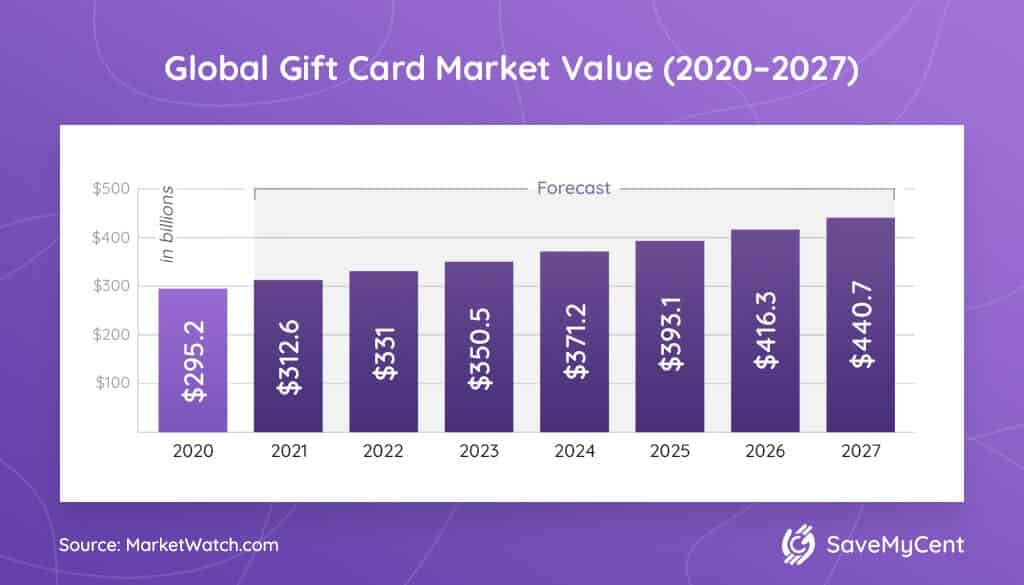
2. The US market is projected to reach $170.78 billion by the end of 2021.
(Research and Markets)
Gift card statistics point to 2021 as another year of strong industry growth, especially during its second half. According to projections, the positive trend will continue over the next four years, with an annual growth rate of 8.8%. By 2025, the industry is expected to reach $238.97 billion, making the United States the world’s leading gift cards market with a share exceeding 50%.
3. 48.5% of the leading online retailers currently accept gift cards.
(Digital Commerce 360, Mageplaza)
A recent survey revealed that almost half of the world’s top 1000 online retailers currently accept gift cards. With the massive rise in online sales due to the pandemic, this number will likely keep growing. Not only are gift certificates convenient for shoppers, but they’re also a great marketing tool for retailers. What’s more, digital gift card statistics show that 59% of consumers who use them as a payment method end up spending more on a purchase than their gift card’s value.
4. Digital gift card adoption among businesses will see a 23% increase by 2025.
(Business Wire)
The shift toward online shopping amid the pandemic will drive more businesses to start offering and accepting digital gift cards in the coming years. In fact, egift card statistics show this market segment will grow at more than twice the rate of overall gift card sales between 2021 and 2025. With physical gift card adoption expected to rise by just 9% over the same period, digital cards will be the market’s fastest growing segment and a significant source of revenue for businesses.
5. Since 2018, Americans have lost close to $245 million on gift card scams.
(Federal Trade Commission, CNBC, Mageplaza)
Gift card scams are by far the most common type of payment fraud in the US. As of 2021, gift card statistics show that nearly 1 in 10 Americans has fallen victim to these scams, costing each of them an average of $840. In a typical gift card scam scenario, the scammer pretends to be calling the victim from some company and asks them to provide the numbers on the back of their gift cards. They then use this information to collect the prepaid sum from the card balance.
There are two types of gift cards: closed-loop and open-loop. While the former can only be used at a specific retailer (e.g., Starbucks or Amazon), the latter runs on a credit card system like Visa or Mastercard and is accepted almost everywhere. To carry out their scams, fraudsters target people with closed-loop credit cards for popular businesses or retailers. They take all the information necessary to redeem the cards, resell it on the internet, and then pocket the cash.
Gift Card Trends in 2020
6. Sales of open-loop gift cards rose by 31.5% amid the COVID-19 pandemic.
(InComm)
During the first half of 2020, US shoppers bought an average of 7.1 open-loop gift cards per quarter. The number marked a significant increase from 5.4 per quarter in 2019 and 4.4 in 2018. At the same time, closed-loop gift card sales experienced a more modest rise — 4.7 per quarter. That’s up 20.5% from 3.9 cards in 2019 and an impressive 80.8% increase from 2.6 in 2018.
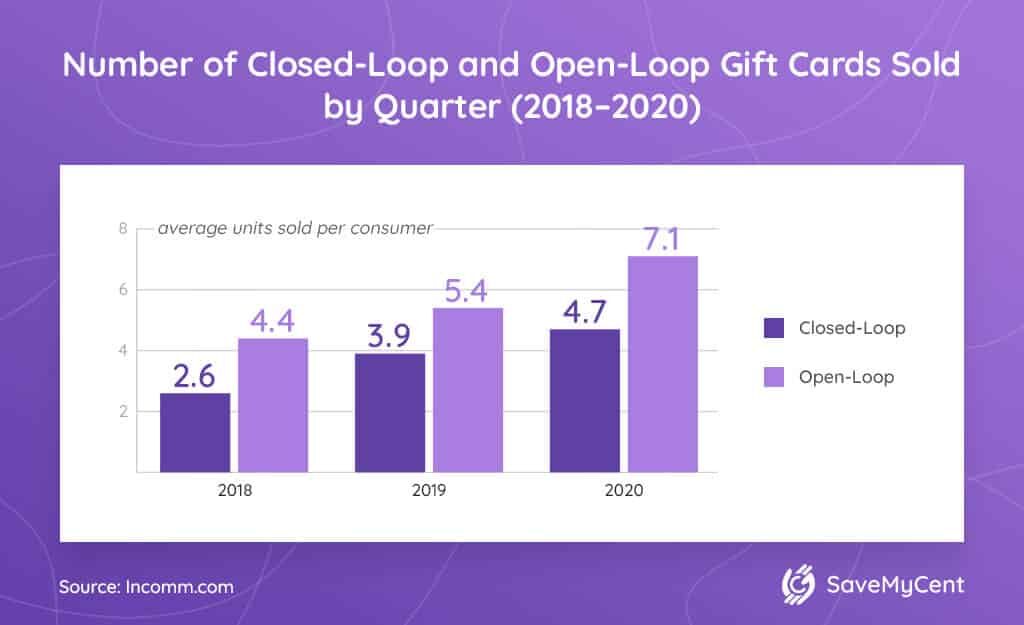
According to experts, these gift card sales statistics aren’t surprising. In light of the pandemic and the boom in online shopping, consumers were increasingly looking for prepaid cards they could use on all platforms they buy from. Also, giving users access to a limited sum of money to spend at a specific store makes closed-loop gift cards safer for online use than credit cards.
7. In-store gift card loads saw a 7% year-over-year decrease in 2020.
(PaymentsJournal)
Americans loaded a total of $146.4 billion onto their in-store gift cards in 2020. This marked a relatively small yet significant decrease from $156.8 billion the year prior, gift card stats show. Furthermore, as the global pandemic forced most people to stay at home and primarily shop on the internet, the number of US shoppers who bought in-store gift cards in 2020 was also down.
8. Restaurant gift card sales dropped by 31.8% in 2020.
(GlobeNewswire, PYMNTS)
Despite this massive drop, restaurant gift card statistics show their market share has remained unchanged from 2019. Unsurprisingly, the holiday shopping season boosted their sales, making up nearly 46% of the total number of restaurant gift cards sold in 2020. And while the year was bumpy for restaurants in general, fast food chains didn’t suffer as much. With the boost in online food delivery orders, their gift card sales accounted for 60% of the food sector’s total card sales.
9. Grocery gift card sales saw a significant increase in 2020.
(InComm)
According to grocery gift card statistics, they were the second biggest selling type of open-loop vouchers in 2020. As for closed-loop gift cards, those for grocery stores and chains placed fifth. With most people buying groceries online while lowering their spend on other product categories amid the COVID-19 pandemic, both varieties of grocery gift cards saw sales increases in 2020.
10. 46% of US consumers bought a gift card on social media in 2020.
(PaymentsJournal)
Social media posted the biggest growth between 2018 and 2020, becoming US consumers’ preferred place to purchase prepaid gift cards. Specialized sites ranked second, with 37% of US shoppers who have bought gift cards there in 2020 — up from 23% in 2018. Gift card sales statistics also show that 36% opted to buy gift cards from banks, up from 19% two years earlier.
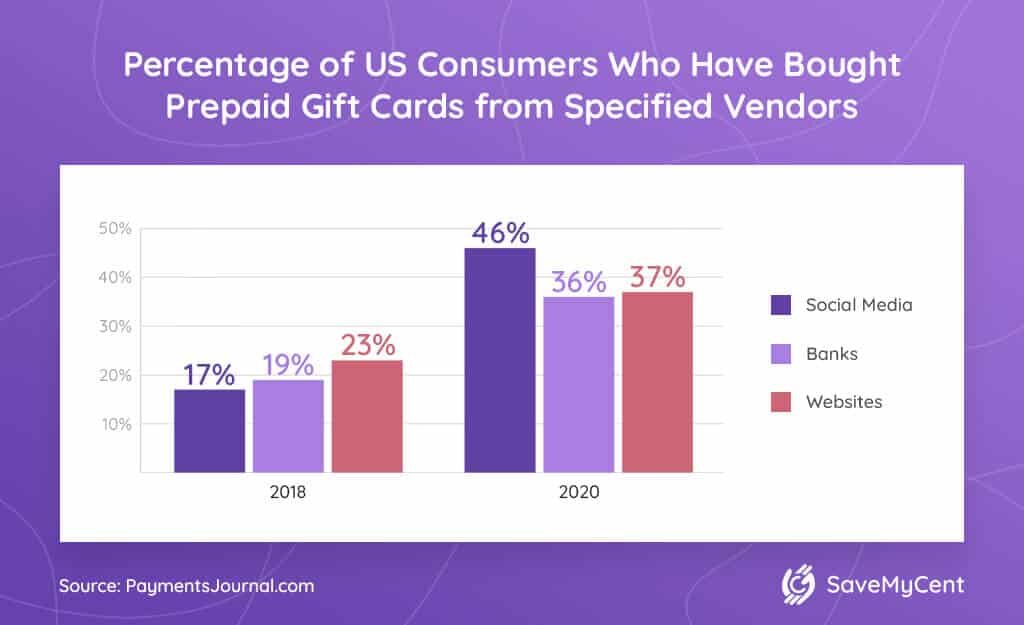
Gift Card Buyer Data
11. Millennials make up 37% of gift card buyers.
(InComm)
Millennials are the most avid gift card buyers, followed by Gen-Xers (28%) and baby boomers (25%). According to gift card demographics, a typical buyer is a married woman without children at home. Exactly half (50%) of all US gift card buyers live in suburban areas, and 68% of them are homeowners. And while income isn’t a significant factor, education is — namely, the majority (64%) of gift card buyers have finished high school, whereas only 14% have a college degree.
12. 37% of closed-loop users often spend more than their card’s value.
(InComm)
Although 81% of closed-loop shoppers carefully plan their purchases, gift card usage statistics show that many tend to spend over their card’s value. When choosing where to purchase closed-loop gift cards, 37% of buyers will look for convenience. Other top factors include the retailer’s product selection (23%), transaction speed (12%), and access to discounts (7%).
13. All generations primarily use their open-loop gift cards for online shopping.
(InComm)
One thing all age groups have in common is using their open-loop gift cards primarily for online shopping. Gift card redemption statistics show clothing is another category all people use their prepaid cards on, but millennials and Gen-Zers do so more than other age groups. Interestingly, Gen-Zers are the generation most likely to use gift cards for gaming gear and health and beauty products. Meanwhile, Gen-Xers are more likely than others to pay bills using their gift cards.
14. 69% of consumers see receiving gift cards from their employers as a reward.
(Blackhawk Network)
More than two-thirds of consumers believe boosting engagement is one of the benefits of giving employees gift cards. On that note, 24% of millennials say they’ve received a physical gift card from their company, while another 12% have received a digital gift card. Similarly, 20% of Gen-Z employees have received a physical and another 14% a digital gift card from their employers. Finally, 19% of Gen-Xers have received a physical and 7% a digital voucher from their company.
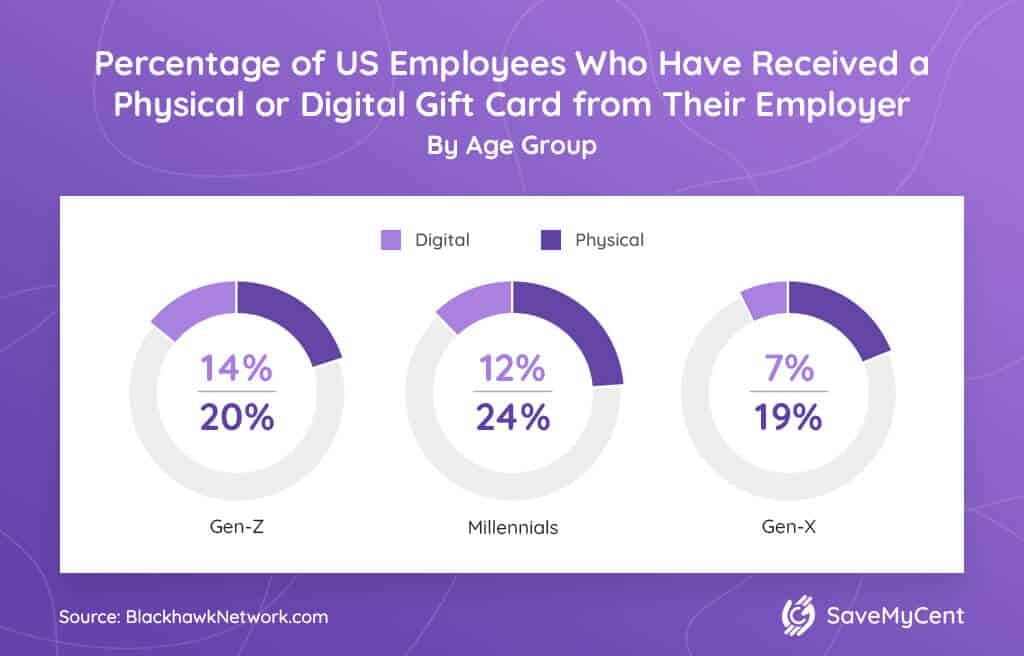
15. Only 22% of Americans would pay more than $3 to personalize their gift cards.
(Blackhawk Network)
Although many retailers offer various personalization options, gift card industry statistics show that most Americans aren’t particularly interested in them. In fact, 46% think personalization isn’t at all important, while 43% wouldn’t be willing to pay extra to have their gift cards personalized.
16. An average US consumer spends $4 more on gift cards for personal use.
(Blackhawk Network)
A closer look at the average gift card amount reveals that Americans tend to spend more when buying gift cards for themselves than when doing so for others. Namely, the average value of a gift card bought for someone else in 2020 stood at $47.91. For comparison, when buying a gift card for personal use, US consumers spent an average of $51.93. Also, while most (20%) buy self-use cards at ecommerce sites, they tend to purchase those for gifting at retail stores (53%).
Holiday Gift Card Statistics
17. Google searches for gift cards regularly spike during the holiday season.
(Google Trends)
One of the unchanging gift card facts is their increased popularity during the winter holidays, even though they’re available all year round. Like clockwork, the spike in searches starts every year in early November, only to peak during the week before Christmas. The search volume then tapers off by mid-January and remains relatively consistent until the next holiday season.
18. 48.28% of all digital gift cards in 2020 were sold in December.
(Rise.ai)
With such high sales, December also accounted for more than half (50.32%) of the total annual gift card revenue. The final quarter of 2020 was very successful for the gift card industry. Not only were the quantities sold twice as high as those from 2019’s fourth quarter, but the sales of digital gift cards also generated 181% more income for retailers than they did the year before.
19. An average online retailer sold 30,774 digital gift cards in December 2020.
(Digital Commerce 360)
Christmas gift card statistics reveal that 2020 brought noticeable changes to the digital gift card landscape. In December alone, the average number of units sold per retailer was up by 106.2% from 14,926 in 2019. The increase was visible throughout the year’s fourth quarter — compared to 2019, the average sales were up by 25% in November and an impressive 77.3% in October.
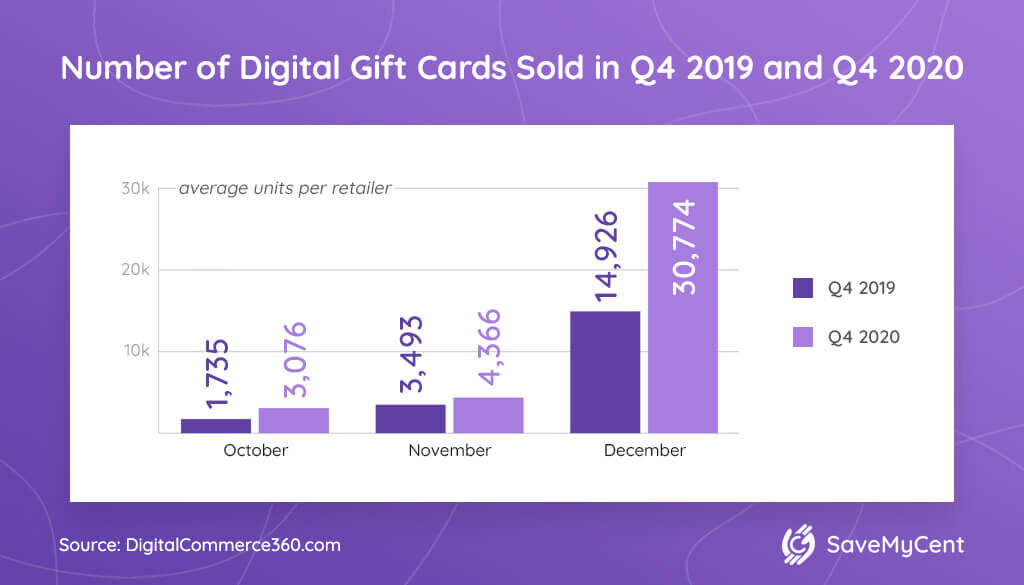
Although the December increase in gift card sales is nothing unusual, the 2020 growth level was unprecedented. Experts see this as a result of the global pandemic — as most people decided against doing holiday shopping in brick-and-mortar stores, they saw ecards as the safest option.
20. 17% of Americans would want a gift card for the holidays, data reveals.
(DealDrop)
According to a recent survey, gift cards rank among the three most desired holiday gifts. At 17%, they are in third place behind cash and surprise gifts (32% each). Most US adults (20%) who cited vouchers as their favorite holiday gift are 65 and over. Gift cards are the most popular choice among the citizens of Alabama (29.3%), North Carolina (25%), and Michigan (19%).
21. Americans planned to spend an average of $21.91 on Mother’s Day gift cards in 2021.
(Statista)
Mother’s Day gift card statistics reveal that Americans spent increasingly more on them each year from 2018 to 2020. Namely, from $19.27 in 2018, the average spend went up to $20.65 in 2019 and then $22.04 in 2020. But after three years of steady increases, 2021 saw a 0.6% drop in intended gift card spending. Although slight, this decrease shows that the 2020 gift card boom was mainly driven by the pandemic, suggesting that future annual growths will likely be smaller.
Unused Gift Card Statistics
22. 51% of US adults forget to redeem their gift cards.
(Bankrate)
The value of these forgotten gift cards is estimated at around $15.3 billion — around $116 per person. However, 95% of people with unused gift cards lying in their drawers say they do plan to use them in the near future. More than half (51%) of them say they’ll use all their gift cards, and 30% plan to use some of the vouchers and store credits they have before their expiration dates.
23. Millennials are most likely to have an unredeemed gift card, usage statistics show.
(Bankrate)
The most avid gift card buyers are also least likely to use one. According to recent research, more than half of all millennials (56%) have at least one unused gift card, with an average per person value of $139 in this age group. Baby boomers follow closely, as 52% of people in this age group have unused vouchers or store credits lying around, estimated at $113 per person.
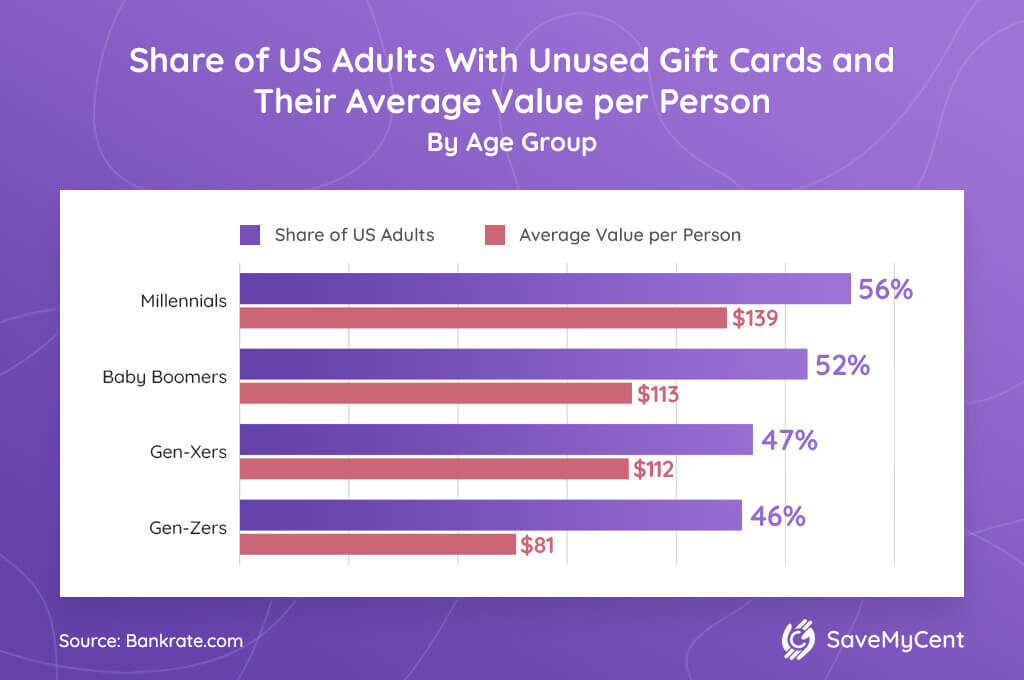
Additionally, 47% of Gen-Xers and 46% of Gen-Zers report having unused gift cards at home. But while the average value of these vouchers for Gen-Xers is $112, it is just $81 for Gen-Zers.
24. Most gift cards remain unused because people wait too long to redeem them.
(Bankrate)
Gift card stats show that 29% of US adults let their vouchers sit unused for too long, allowing them to expire rather than using them on time. Another 27% say they didn’t use their gift cards because they couldn’t find them, while 21% had the bad luck of the business closing before they had a chance to redeem their store credit. The latter is becoming increasingly common as more and more small businesses are shutting down due to the pandemic’s adverse economic effects.
25. Gift card breakage statistics show a 25% drop in unused vouchers in 2020.
(Bankrate)
The term gift card breakage refers to the share of gift cards that don’t get redeemed. Although experts believed the lockdowns in 2020 would lead to an increase in this number, the statistics proved them wrong. In fact, as most people became more conscious about their finances amid the pandemic, they decided to spend what had already been paid for. This, along with the rise of ecommerce in 2020, led to a 25% decrease in the share of unused gift cards compared to 2019.
Gift Card Stats: In Conclusion
Despite the market not reaching its initially projected value, 2020 was still a poster year for gift cards. Their sales — especially of the open-loop type — saw a massive increase during the pandemic. Most people turned to online shopping while stuck at home, and many of them used digital gift cards as a payment method. As such, the number of unused gift cards dropped by 25% year-over-year, and holiday sales figures surged to a new high, doubling those from 2019.
As impressive as it was, early 2021 numbers show that the previous year’s pandemic-fueled industry growth may have been slightly unrealistic. The gift cards market will continue growing, but at a considerably slower pace — 5.9% a year by 2027, eventually reaching $440.7 billion.
FAQ
Why do people buy gift cards?
People buy gift cards for various reasons. As the name suggests, they are an excellent gift for someone else, but they’re also a good substitute for cash when bought for personal use. Some retailer-specific gift cards give users access to discounts and other loyalty perks. Finally, both varieties of digital gift cards provide a more secure online payment method than credit cards.
Who buys gift cards?
Consumers from all walks of life and income brackets buy gift cards, but the typical buyer is a married woman with no children at home. As for the age breakdown, 37% of gift card buyers are millennials, 28% are Gen-Xers, and 25% are baby boomers. There are also differences in terms of education — only 14% of buyers have a college degree, while 64% have finished high school.
What percentage of gift cards are digital?
According to research, 60% of all purchased gift cards are digital. With most people in lockdown during the pandemic, the average physical gift card load dropped by 7% in 2020. But gift cards in general had a rather successful year. Open-loop cards saw a 31.5% increase in sales, with an average of 7.1 cards sold per customer during each quarter of the year. Similarly, closed-loop sales were up by 20.5% — from 3.9 gift cards per quarter in 2019 to 4.7 per quarter in 2020.
What percentage of gift cards are redeemed?
A recent survey found that about 80% of gift cards are redeemed within a year of purchase. Most buyers are quick to take advantage of their gift cards — over 70% of all purchased gift cards end up redeemed within the first six months. But the numbers decrease from there, with merely 10% more cards redeemed within the next 180 days. Even if their gift cards haven’t expired by the one-year mark, consumers are highly unlikely to use them from that point on.
What percentage of gift cards are never redeemed?
Between 10% and 19% of gift cards are unredeemed at any given point. However, most buyers end up using their gift cards eventually, leaving only 6% that are never redeemed. According to gift card statistics, millennials are most likely to have at least one unredeemed gift certificate in their drawers. A recent study found that 56% of millennial consumers have at least one unused gift card, followed closely by baby boomers at 52%, Gen-Xers at 47%, and Gen-Zers at 46%.
Sources:







![How to Get Free Clothes From Shein? [2024 Guide]](https://savemycent.com/wp-content/uploads/2023/09/How-to-Get-Free-Clothes-From-Shein-336x220.png)
